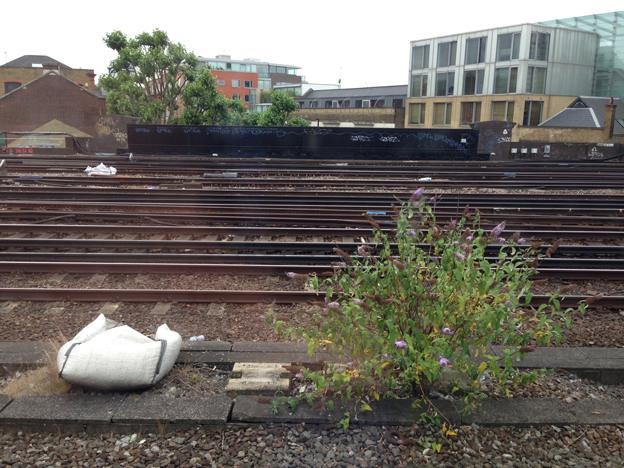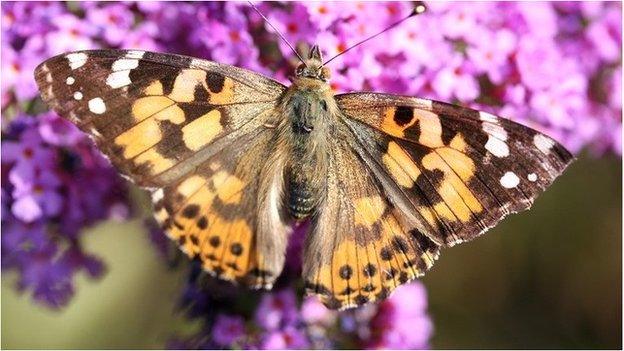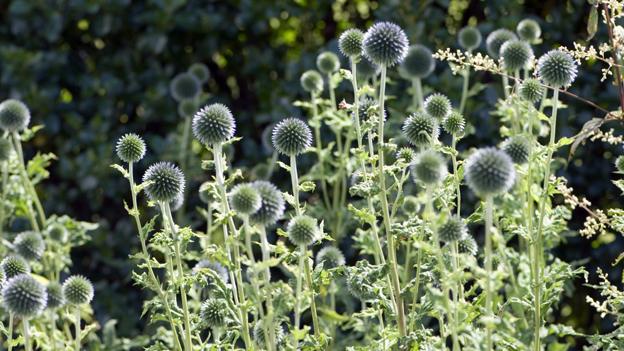Buddleia: The plant that dominates Britain's railways
- Published

More people are buying buddleia for their gardens, but it's classified as an invasive species and is a problem on British railways.
It's hard to walk by a railway line in Britain and not see buddleia.
Along fences by the tracks and almost any patch of waste ground, you will notice the long, slender clumps of flowers, usually lilac but also blue, deeper purple or white, at the end of long, arching branches.
BBC weather forecaster Peter Gibbs says the mild, wet winter will have improved germination and growth this year, especially in areas where water normally drains away quickly, such as derelict urban sites. "Buddleia is an opportunist that's always ready to capitalise on any slight advantage."
Sprouting from seemingly every derelict building, it stakes an increasingly plausible claim for the title of Britain's national flower.

Buddleja davidii

Also called summer lilac, butterfly-bush, or orange eye, native to Sichuan and Hubei provinces in central China and Japan
Named after Basque missionary and zoologist, Father Armand David (1826-1900)
First introduced to Europe in the late 19th Century

And the plant is increasingly a favourite with gardeners. Homebase saw a 20% sales increase over the past four months compared with the same period last year.
It's popular for both the range of colours and its butterfly-attracting properties. The Royal Horticultural Society describes buddleia in all its forms as "beloved" to gardeners.
But Buddleja davidii, to give its latin name, which originated in China, is viewed by the Department for the Environment, Food and Rural Affairs (Defra) as an invasive non-native species. Its "invasion history, external" has been charted from its introduction to the UK in the 1800s to the first record of the plant in the wild in 1922.
Defra says the highly-dispersible seed of what was originally a garden plant has resulted in extensive buddleia populations in the wild, where the shrub has often out-competed native vegetation and reduced biodiversity.
Gardeners are being asked by Defra to remove seed heads after flowering to prevent its spread before it becomes "ubiquitous".
The plant can cause damage to buildings, such as crumbling brickwork - its tiny wind-blown seeds can germinate in decaying mortar.
And the problems caused by buddleia to the management of the rail network are described by the Non-Native Species Secretariat as "significant".

Buddleia on the tracks
Network Rail says buddleia has a habit of growing in walls where it can interfere with overhead power lines and obscure signals. While it does not cause "serious" problems such as blocking train lines, it does have a habit of popping up in "annoying places" where removing it takes up valuable time and resource.
The company cuts down large buddleia before removing or killing the stumps, sprays small buddleia with herbicide, and uses weed-killing trains to keep the network clear, while staff use portable sprayers at stations.
One would think that the potential for nuisance might be outweighed by the benefits to wildlife, such as butterflies.

Buddleia "has a habit of growing in walls"
Butterfly Conservation is one of the wildlife organisations that recommends planting buddleia, external for its summer nectar that the creatures feed on, but admits the plant has to be treated with caution.
The charity says the plant can cause serious problems on conservation sites. It advises against planting buddleia where it may be unmanaged and recommends gardeners remove seed heads. "It spreads incredibly quickly," says spokesman Liam Creedon.
Buddleia has been blamed for the destruction of chalk grassland at Folkestone Warren, a site of special scientific interest (SSSI) in Kent. Kirk Alexander, White Cliffs Countryside Partnership project manager, says the prolific flowers are "impressive", but partly as a result of their spread, only a small area of grassland now remains on the 199-hectare site, which is protected for its chalk grassland as well as its geology, wildlife and fossils.

The buddleia attracts butterflies and insects but gardeners are being urged to help prevent its spread
"If left uncontrolled, then buddleia and other shrubs would have engulfed the chalk grassland," he says. Clouds of butterflies used to be seen there, but now only common species can be spotted and even these are in decline, with the rarest ones disappearing altogether.
Buddleia was eliminating butterfly habitat by killing off everything else, and while the shrub provided food for adults and larger insects, other plants were needed for butterflies in their larval stages, he explains.
"If people's gardens are on land next to an SSSI, they might want to think about what they plant and certainly don't throw garden waste over the fence," says Alexander.
Both Homebase and garden centre chain Dobbies emphasise they offer dwarf and ornamental varieties as an alternative to the buddleia types that spread easily.

At Notcutts garden centres, senior plant buyer Colin Dale says the company still encourages customers to choose bee and butterfly-friendly plants, including buddleias
"There has been a shift from the towering buddleias that we had 20 or more years ago to new dwarf patio buddleias and compact series," he explains. But there are plenty of other places that do sell the full-size buddleia.
Of course, the plant is only a problem when it's in the wrong place. When in the right place, its nectar attracts insects, which in turn attract birds and bats, and the shrub's dense thickets provide cover for foxes and badgers.

More from the Magazine

They are the scourge of farmers and allotment holders the world over. But, one naturalist asks, should we look at weeds in a different light?

Section 14 of the Wildlife and Countryside Act, external includes, under Schedule Nine, a list of plant species to which offences apply. The list does not include buddleia.
Guy Barter, chief horticultural adviser at the RHS, which has given four buddleia davidii plants Awards of Garden Merit, external, says the species has not and had never been proposed for Schedule Nine. "If it was on Schedule Nine, people could still grow it in gardens, but as an act of responsible horticulture we would refrain from promoting it."
The plant has sold steadily and is very popular with the public, while buddleia other than the davidii species pose no threat, and seedless clones are available, he explains.
"We do suggest de-seeding it, but in urban areas there is often so much on wasteland that even if every gardener dead-headed their buddleia the effect would not be very great," he said.
There's no escape from buddleia.
To find out more about invasive plants, listen to Plant Invaders, episode nine of Plants: From Roots to Riches on BBC Radio 4 at 1:45 BST on 31 July 2014, also available as a free download.
Subscribe to the BBC News Magazine's email newsletter to get articles sent to your inbox.
Share your pictures of buddleia by tweeting with #buddleiaonthetracks, external or using the instructions below.